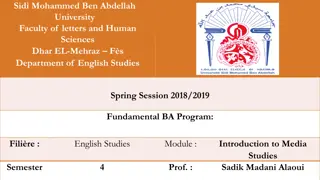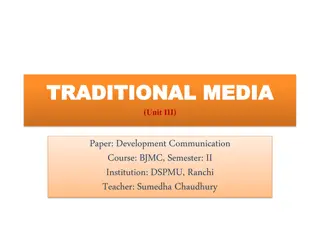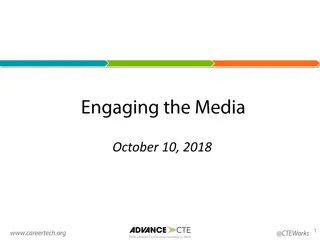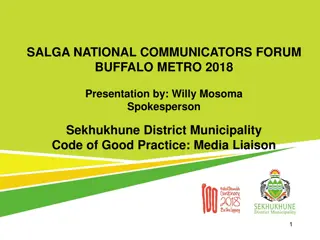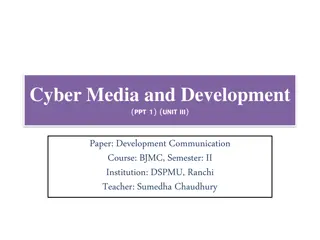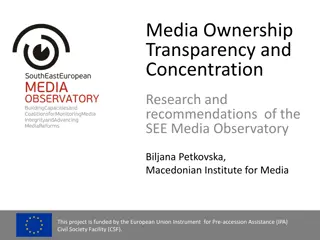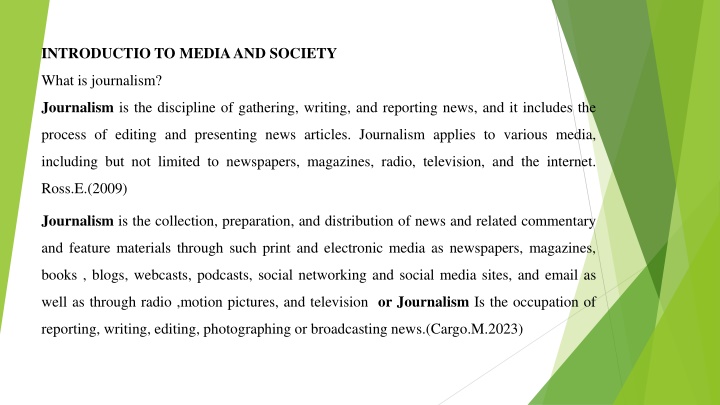
Essentials of Journalism: Principles and Functions
Discover the fundamental components, functions, and core principles of journalism including truth, independence, fairness, and impartiality. Learn about the importance of providing accurate, objective, and credible information while engaging readers effectively through journalistic writing.
Download Presentation

Please find below an Image/Link to download the presentation.
The content on the website is provided AS IS for your information and personal use only. It may not be sold, licensed, or shared on other websites without obtaining consent from the author. If you encounter any issues during the download, it is possible that the publisher has removed the file from their server.
You are allowed to download the files provided on this website for personal or commercial use, subject to the condition that they are used lawfully. All files are the property of their respective owners.
The content on the website is provided AS IS for your information and personal use only. It may not be sold, licensed, or shared on other websites without obtaining consent from the author.
E N D
Presentation Transcript
INTRODUCTIO TO MEDIA AND SOCIETY What is journalism? Journalism is the discipline of gathering, writing, and reporting news, and it includes the process of editing and presenting news articles. Journalism applies to various media, including but not limited to newspapers, magazines, radio, television, and the internet. Ross.E.(2009) Journalism is the collection, preparation, and distribution of news and related commentary and feature materials through such print and electronic media as newspapers, magazines, books , blogs, webcasts, podcasts, social networking and social media sites, and email as well as through radio ,motion pictures, and television or Journalism Is the occupation of reporting, writing, editing, photographing or broadcasting news.(Cargo.M.2023)
Components of Journalism These are the elements of journalism. The first among them is that the purpose of journalism is to provide people with the information they need to be free and self- governing. To fulfill this task: B. covach (2007). Journalism's first obligation is to the truth. Its first loyalty is to citizens. Its essence is a discipline of verification. Its practitioners must maintain an independence from those they cover. It must serve as an independent monitor of power. It must provide a forum for public criticism and compromise. It must keep the news comprehensive and in proportion. Its practitioners have an obligation to exercise their personal conscience. Citizens, too, have rights and responsibilities when it comes to the news.
Functions of journalism in the society: (Munir. S 2017) Inform Pursued Educate Interpret Mold opinion Enable decision making Agent of change and Entertain
What needs to be done while functioning/Writing: Reader Interest, Accuracy Objectivity Credibility Readability Significance Clarity and Personality.
Functioning/writings cause the reader to: Stop Be interested Think Learn Understand Enjoy Remember Discuss Change
These are the five core principles of journalism Truth and Accuracy : Journalists cannot always guarantee truth , but getting the facts right is the cardinal principle of journalism. We should always strive for accuracy, give all the relevant facts we have and ensure that they have been checked. Independence : Journalists must be independent voices; we should not act, formally or informally, on behalf of special interests whether political, corporate or cultural. We should declare to our editors Fairness and Impartiality : Most stories have at least two sides. While there is no obligation to present every side in every piece, stories should be balanced and add context. Objectivity is not always possible, and may not always be desirable (in the face for example of brutality or inhumanity), but impartial reporting builds trust and confidence.
Principles of journalism continues. Humanity: Journalists should do no harm. What we publish or broadcast may be hurtful, but we should be aware of the impact of our words and images on the lives of others. Accountability: A sure sign of professionalism and responsible journalism is the ability to hold ourselves accountable. When we commit errors we must correct them and our expressions of regret must be sincere not cynical. We listen to the concerns of our audience. We may not change what readers write or say but we will always provide remedies when we are unfair.
HISTORY OF JOURNALISM After knowing the concept of journalism at large here now is the short history of journalism in other words we are looking the background, the beginning of something so cold journalism. History of journalism in the world It should be known that before the history of printing press was invented, word of mouth was the primary source of news. Newspaper have always been the primary medium of journalists since 1700, with magazines added in the 18th century (which is also the 1700s) radio and television in the 20th century , and the internet emerged in the last quarter of 20th century. To trace back the history of newspaper in the world sometimes is complex due to the fact that, it differ from one country to another. Jerilyn (1987) argues that, the first newspaper were the handwritten news sheet that circulated widely in Venice as early as 1566.
History of journalism in the world continue. Johannes Weber (2006)argues that, modern newspapers started to be published in the 17thc as a results of printing press technology which was discovered by Johannes Gutenberg (a German) in 15thc. The first newspaper / newsletter in Rome dates back all the way to 59 BC. The newspaper was called The Acta Diurna ( Acta Populi or Acta Public ) in Latin which means daily Acts and Events of The Roman Public. The Acta was launched by Julius Caesar during the later times of the republic, and under the empire; as an official publication of his government. The style of the Acta was very simple and concise. Its motto was Publicize and Propagate. The Acta was written on papyrus paper and sometimes carved on stone or metal. It had a substantial readership because it was posted around the city and distributed in the prominent places of Rome. The Acta also tied into the oral tradition, and it was read aloud in public places.
History of journalism in the world continue. Acta Diurna survived two centuries. The Acta provided first the details of government business, proclamations and resolutions, military, political and court news. Then its content was expanded to other announcements and information such as: prominent births, deaths, marriage, divorce, crimes, trials, After being posted for a reasonable amount of time, the notices were taken down, and they were archived. Nevertheless, no intact copy has survived to the present day. History of journalism in Tanzania Stumer(1998) argues that the history of newspaper in Tanzania can be grouped in three phanses namely: Colonial era, during the struggle for independence, and post colonialism. Periodically, newspapers in Tanzania started in the last quarter of 19th century. That is to say, the development of newspapers described by Sturmer (1998) in relation to Tanzania, based on periodization and each period had its own policy and focus.
History of journalism in Tanzania continues. Newspaper during that particular time were used as a medium of information, educating, entertaining and persuading people, but their roles differed in accordance with time. For instance during colonialism , newspapers like Morogoro news and theplanters focused on promoting farmers and colonialism propagandas , but during the struggle fro independence newspapers like SAUTI ya TANU, Uhuru and Mzalendo used to create awareness and groom people s consciousness about the evils done by colonialists, and after the independence newspapers started to increase in number mainly were used for boosting ujamaa s ways of grooming Tanzania economy (Sturmer , 1998).
History of journalism in Tanzania continues. After independence , several newspapers were established including The daily news which was the result of a forced merger of two papers the Standard was first published as the Tanganyika Standard in January 1930 by the Kenyan East Africa Standard LMD, until 1967 when it was taken over by a multinational London Rhodesian Company (LONRHO)After the creation of Tanzania in 1964, it because simply The Standard. On 5 February 1970, the paper was nationalized by the Tanzanian government. The nationalist was first published on 17 April 1964, as a Government owned daily, and struggle to complete with the standard. On 16 Janury 1972, TANU decide to end the rivalry between papers and forced am merger : The new Paper, Daily new was first published on 26 April 1972 The company which publishes it retained the name standard and is still known as tanzana standard(Newspapers)Limited:
History of journalism in Tanzania continue. Its Kiswahili sister paper Habari leo wa established in 2007. It is in tabloids form, unlike the Daily News which together with the Sunday new are all broadsheets.On 30 December 2011, daily news announced its intention to launch a newly designed website in a move that was aimed to extend its readership and keep abreast with latest developments in Information And Communication Technology (ICT).Additionaly newspapers including Mwananchi, Nipashe, mwanahabari, The African, The Guardian, Majira, Mawio, Jambo leo, Tanzania Daima just to mention a few were established. Thanks .
MOBILAZATION ROLE OF JOURNALISM Concept of mobilization role 1. According to Ucheanya (2003), mobilization increases people's participation in any social change issue. It has also been described as an effort aimed at mustering a national support for a successful program (Nyiranda, 1995, cited in Ucheanya, 2003). 2. Mobilizing people here refers to efforts made (through the mass media) to encourage or facilitate participation of the masses for developing their community. The mass media are essential to the achievement of such task. 3. In the same vein, Urnechukwu (2004) defines mobilization as "all efforts and means legitimately employed to encourage, ginger and get the people ready to take actions aimed at achieving the goals and aspirations of societv .
Approaches of media in the mobilization of society The approach of the mass media in this aspect could be deduced from their general functions in the society As information agents. The mass media should keep the people informed about development projects, programmes or issues that are either on-going or that need attention in their communities. Development communication objective of the press. People should be informed about development programmes, whether initiated by government or other change agents, that affect their community and the society at large. Adequate information will make people aware of how to contribute their own quota to development In any area health, politics, environment, social sphere, among others.
Approaches of media in the mobilization of society Information. People can make meaningful decisions required for development if they are adequately informed about the activities of government and the events that occur, issues arising from such events, government actions and inaction and even public opinion on issues and events (Keghku , 2003). Education. The mass media, through good (broadcast) programmes and featurized development news reports, could educate people on how certain developmental activities would be of benefit to them if executed in their locality. For instance, the polio eradication campaign, which was initially rejected in Kano State, could aptly be referred to as a health development project. The media, especially the broadcast media, used the language of the people of the state (Hausa) to educate the public on the essence of the campaign and the safety of the vaccine.
Approaches of media in the mobilization of society The mass media create awareness, interpret issues and awaken the interest of people towards developing their communities. Active, constructive and participatory planning processes involved in originating and executing developmental ideas, when emphasized by the media, spur actions on the part of people in a community








